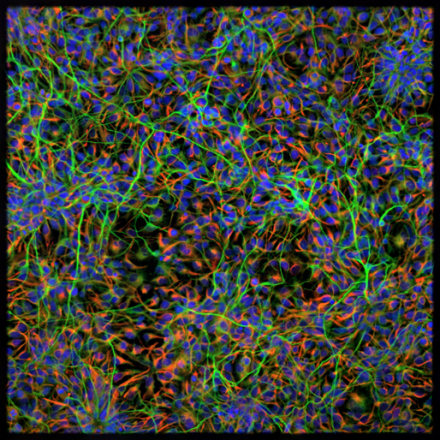The NIH Intramural Research Program has a long history of interactions and shared resources among investigators. These include core facilities that support crucial research activities, such as a sequencing center, a magnetic resonance imaging facility, a mass spectroscopy service, and a protein expression service to note just a few.
Below you will find NIH Shared Facilities listed alphabetically.
A-L
|
The Biomedical Engineering and Physical Science (BEPS) is centrally located on the main NIH campus, and provides expertise that spans technologies ranging in scale from near-atomic resolution to intact organisms. |
|
The Chemistry and Synthesis Center (NHLBI) provides molecular imaging probes for biological research within the NIH Intramural community and their collaborators. In general, the CSC prepares 3-10 compounds per project and provides initial compounds within 3 to 6 months. |
| The NIH Collaborative Research Exchange (CREx) is an online platform offering a vast catalog of research services to facilitate communications between IRP scientists and internal cores as well as external vendors, enabling IRP scientists to easily engage with innovative resources and technologies. |
|
The Computational Structural Biology of the BCBB (NIAID) develops and applies theoretical and computational methods to biological problems at the molecular level. Our work encompasses a broad range of topics relevant to structural biology, from quantum chemical calculations of small molecules to large-scale simulations of macromolecules and their complexes. |
|
The Functional MRI Facility (NIMH/NINDS) is a core resource serving the intramural research program. Its function is to serve as a resource by which all NIH institutes can perform Magnetic Resonance Imaging (MRI) studies that further the understanding of healthy and diseased brain anatomy, function and physiology. |
| The Instrumentation Section (NIMH/NINDS/NICHD) provides a staff of engineers and technicians to fabricate custom electronic, mechanical, and electromechanical devices and instruments for a full spectrum of biomedical applications. |
| The NIH Intramural Sequencing Center (NISC) is a multi-disciplinary genomics facility that emphasizes the generation and analysis of DNA sequence. In addition to providing investigators at the NIH access to well established, high-throughput DNA sequencing, NISC works closely with NIH collaborators to explore the use and implementation of leading-edge genomics technologies, molecular biology protocols and analytical procedures. |
M-Z
|
The Microarray Tech Core (NHGRI/NIMH/NINDS) is a collaborative effort between NINDS, NIMH and the National Human Genome Research Institute (NHGRI) to establish a microarray core facility for Intramural investigators. The Microarray Core Facility is run by the NHGRI. |
|
The Molecular Immunology Center (NHLBI), led by Dr. Warren J. Leonard, focuses on the biology, signaling, and molecular regulation of a key family of these cytokines, the interleukins, with studies ranging from basic molecular mechanisms to human disease. |
| The NIH MRI Research Facility/Mouse Imaging Facility is a shared, intramural resource for human imaging studies. The NMRF is supported by all Institutes at NIH and reports to the Shared Resources Subcommittee (SRS) of the Scientific Directors. Administratively, NMRF resides within NINDS. The NMR Center Steering Committee provides the direct oversight for NMRF activities. |
|
The Multi Institute Cryo-EM Facility (MICEF) is a collaborative facility maintained by NIDDK. It serves the scientific communities of NHLBI, NIDDK, NIAMS, and NINDS. The facility allows for fully-automated atomic-resolution single-particle data collection using SerialEM and Leginon. |
| The Neurophysiology Imaging Facility (NIMH/NINDS/NEI) provides anatomical and functional MRI scanning for researchers in NIMH, NEI and NINDS. The 3 Tesla Siemens Prisma and 4.7 Tesla vertical Bruker magnets are two of a handful of scanners in the world dedicated to functional imaging in the alert primate brain. |
|
The PET Department (Clinical Center) is a large, state-of-the-art facility. It has three medical cyclotrons, ten hot cells to produce positron labeled radiopharmaceuticals and four PET scanners. There is a large dedicated team of physicians, scientists, cyclotron engineers, radiochemists, radiopharmacists, and nuclear medicine technologists staffing the Department. |
|
The RNAI@ NIH Chemical Genomics Center/ Functional Genomics Lab (NCATS) state-of-the-art RNAi screening facility accepts proposals from any NIH researcher. NCATS staff assist investigators with all stages of project planning and execution, from assay development through genome-wide small-interfering RNA (siRNA) screens, informatics and pathway analysis, and rigorous follow-up. |
|
The primary mission of the NIH Stem Cell Unit (SCU) is to characterize and compare pluripotent human stem cells. We have analyzed the growth and culture conditions of all 21 human embryonic stem cell lines approved under the August 2001 Presidential Executive Order. Here we make available to the scientific community the results of our rigorous characterization of these cell lines at a more advanced level. |
|
The Transgenic Mouse Facilities (NIMH) (NHGRI) mission is to discover the role of specific genes in the development and function of the nervous system. In some neurological diseases the genetic basis of pathology is know and can be modeled in mice. |

(PI: Avindra Nath @nathavindra)
Various mechanisms are used to support these resources, including contributions from participating NIH institutes and centers such as the management funds, user fees, and program support from the Office of Intramural Research.
